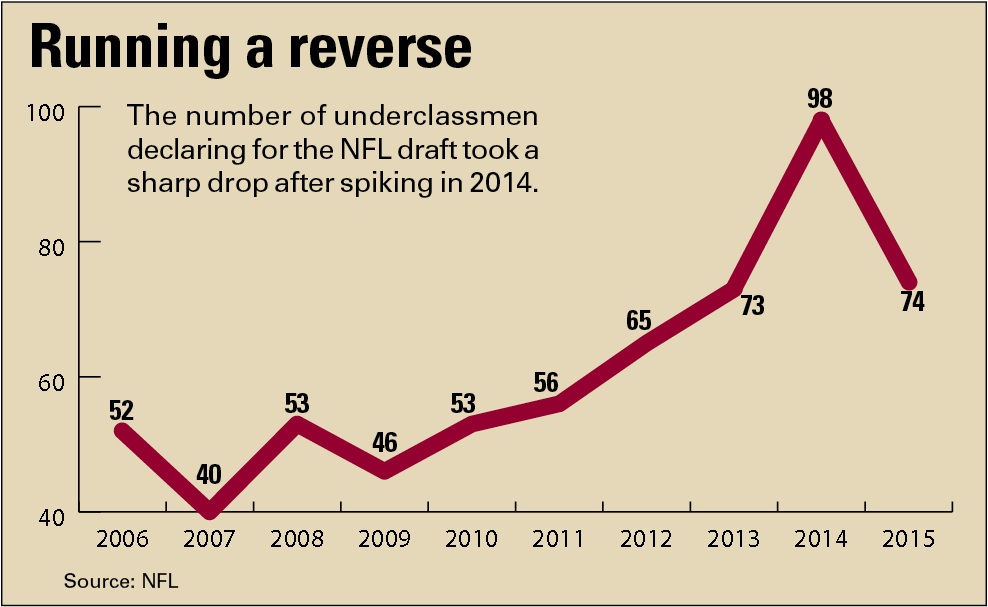The number of college football underclassmen declaring for the NFL draft went down this year, reversing a five-year trend, and talent experts credit better education and a new NFL grading system for the drop.
Seventy-four players were granted special eligibility for the NFL draft, down 24.5 percent from a record high of 98 in 2014. Before that, the number had been climbing steadily since 2009, when 46 players with college eligibility declared for the draft (see chart).
“Hopefully, 2014 was a one-year anomaly and the number in 2015 will begin a trend back to the historical averages,” said Rich McKay, Atlanta Falcons president and CEO and the chairman of the NFL Competition Committee.
Last year McKay decried the record number as “surprising” and “disappointing.” Thirty-six of those 98 players were not drafted.
McKay, NFL agents and others said that the new NFL grading system, which went into effect last year, may have something to do with the drop.
Previously, college underclassmen who requested a draft grade from the NFL were given one of five grades:
■ Potential first-rounder.
■ Potential second-rounder.
■ Potential third-rounder.
■ Potential fourth- through seventh-rounder.
■ Projected free agent.
The new NFL evaluation system has only three grades:
■ Ability of potential first-rounder.
■ Ability of potential second-rounder.
■ Recommendation to remain in school.
In addition to the new grading system, the NFL also implemented a limit on the number of grades a school could request. In the past, the number of requests was unlimited. This past year, once a college had five players reviewed by the NFL’s College Advisory Committee, the school had to ask permission to get additional reviews. It was not clear how often such permission was granted.
McKay said the new rules appear to have helped reduce the number of early entrants. “That said, it’s only been one year with these modifications,” he said.
Jeff “Hawk” Hawkins, University of Oregon director of football operations, said he worried at first that the new system might send the wrong message to underclassmen not projected as first- or second-rounders.
“I was afraid … the kids would think, ‘Well, I’ll go in the third [round],” Hawkins said. “I was really concerned that they would read between the lines when they shouldn’t.”
Hawkins said he was pleasantly surprised by the numbers and said that the new grading system seems to have had an effect.
Todd McShay, ESPN NFL draft analyst, said both the new grading system and the limit on evaluations may have kept the number down. “I think the combination of the two things was very smart,” he said.
The large number of juniors and redshirt sophomores declaring last year wasn’t due to underclassmen trying to take advantage of a weak class, McShay said. “This 2014 rookie class is one of the better rookie classes — I would say — in a decade.”
McShay noted that the number of underclassmen declaring for the draft took a jump after the negotiation of the 2011 collective-bargaining agreement, which instituted a new rookie pay system. Those new rules cut the amount of money that high first-rounders could make by about half.
Nowadays, agents are telling draft prospects that it is all about getting the second contract, where the real money can be made. If players come out one or two years early, they are closer to that second contract.
“The problem we are having is guys are coming out before they are ready,” McShay said. “And it doesn’t matter if you are closer to it, because ‘it’ [the second contract] doesn’t exist.”
Gil Brandt, a draft analyst for NFL.com, who makes the decision on which players are invited to the draft, said he thinks the reason fewer underclassmen came out this year is because college coaches did a better job of telling players about the underclassmen who declared last year but were not drafted.
While the number of underclassmen who have declared for the draft has gone up in recent years, the number who are actually drafted has not, said Lal Heneghan, a partner with Cornerstone Sports Consulting, which provides education about the NFL to college football players at 12 Division I schools, including Alabama and Florida State.
Universities are spending more time educating players about the pitfalls of declaring early, including the possibility of going undrafted, Heneghan said. The decrease in the number of underclassmen declaring could mean those players are going to stay in school and develop both as football players and individuals, Heneghan said.
If so, Heneghan said, “that is a good thing.”




